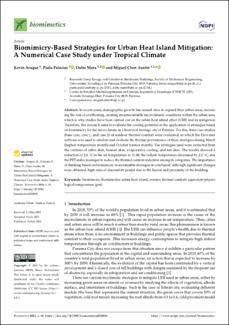| dc.contributor.author | Araque, Kevin | |
| dc.contributor.author | Palacios, Paola | |
| dc.contributor.author | Mora, Dafni | |
| dc.contributor.author | Chen Austin, Miguel | |
| dc.date.accessioned | 2022-01-12T13:11:51Z | |
| dc.date.available | 2022-01-12T13:11:51Z | |
| dc.date.issued | 2021-07-06 | |
| dc.identifier.uri | https://doi.org/10.3390/biomimetics6030048 | |
| dc.identifier.uri | https://ridda2.utp.ac.pa/handle/123456789/13483 | |
| dc.description | In recent years, demographic growth has caused cities to expand their urban areas, increasing the risk of overheating, creating insurmountable microclimatic conditions within the urban area, which is why studies have been carried out on the urban heat island effect (UHI) and its mitigation. Therefore, this research aims to evaluate the cooling potential in the application of strategies based on biomimicry for the microclimate in a historical heritage city of Panama. For this, three case studies (base case, case 1, and case 2) of outdoor thermal comfort were evaluated, in which the Envi-met software was used to emulate and evaluate the thermal performance of these strategies during March (highest temperature month) and October (rainier month). The strategies used were extracted from the contrast of zebra skin, human skin, evaporative cooling, and ant skin. The results showed a reduction of 2.8 C in the air temperature at 11:00, the radiant temperature decreased by 2.2 C, and the PET index managed to reduce the thermal comfort indicator among its categories. The importance of thinking based on biomimicry in sustainable strategies is concluded; although significant changes were obtained, high risks of discomfort persist due to the layout and proximity of the building. | en_US |
| dc.description.abstract | In recent years, demographic growth has caused cities to expand their urban areas, increasing the risk of overheating, creating insurmountable microclimatic conditions within the urban area, which is why studies have been carried out on the urban heat island effect (UHI) and its mitigation. Therefore, this research aims to evaluate the cooling potential in the application of strategies based on biomimicry for the microclimate in a historical heritage city of Panama. For this, three case studies (base case, case 1, and case 2) of outdoor thermal comfort were evaluated, in which the Envi-met software was used to emulate and evaluate the thermal performance of these strategies during March (highest temperature month) and October (rainier month). The strategies used were extracted from the contrast of zebra skin, human skin, evaporative cooling, and ant skin. The results showed a reduction of 2.8 C in the air temperature at 11:00, the radiant temperature decreased by 2.2 C, and the PET index managed to reduce the thermal comfort indicator among its categories. The importance of thinking based on biomimicry in sustainable strategies is concluded; although significant changes were obtained, high risks of discomfort persist due to the layout and proximity of the building. | en_US |
| dc.format | application/pdf | en_US |
| dc.language.iso | eng | en_US |
| dc.publisher | MDPI | en_US |
| dc.rights | info:eu-repo/semantics/openAccess | en_US |
| dc.rights | https://creativecommons.org/licenses/by-nc-sa/4.0 | en_US |
| dc.subject | biomimicry | en_US |
| dc.subject | biomimetics | en_US |
| dc.subject | urban heat island | en_US |
| dc.subject | exterior thermal comfort | en_US |
| dc.subject | equivalent physiological temperature (pet) | en_US |
| dc.title | Biomimicry-Based Strategies for Urban Heat Island Mitigation: A Numerical Case Study under Tropical Climate | en_US |
| dc.type | info:eu-repo/semantics/article | en_US |
| dc.type | info:eu-repo/semantics/publishedVersion | en_US |
